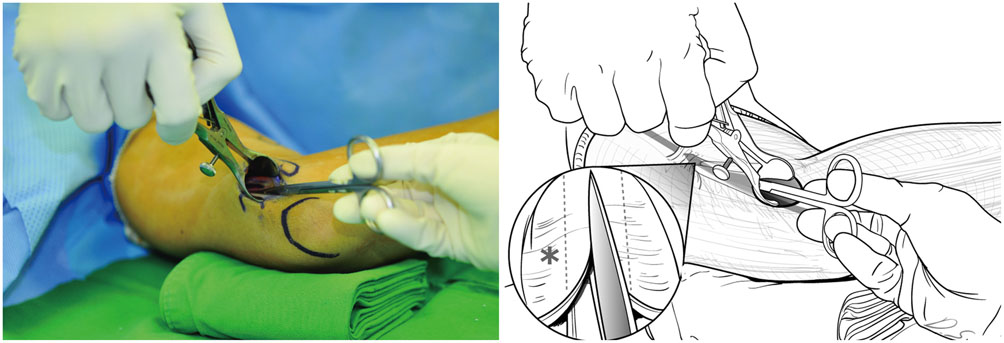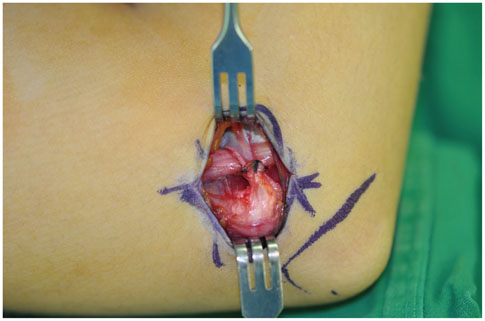Yonsei Med J.
2016 Mar;57(2):455-460. 10.3349/ymj.2016.57.2.455.
Factors Influencing Outcomes after Ulnar Nerve Stability-Based Surgery for Cubital Tunnel Syndrome: A Prospective Cohort Study
- Affiliations
-
- 1Department of Orthopedic Surgery, Severance Hospital, Yonsei University College of Medicine, Seoul, Korea. yrchoi@yuhs.ac
- KMID: 2374053
- DOI: http://doi.org/10.3349/ymj.2016.57.2.455
Abstract
- PURPOSE
Simple decompression of the ulnar nerve has outcomes similar to anterior transposition for cubital tunnel syndrome; however, there is no consensus on the proper technique for patients with an unstable ulnar nerve. We hypothesized that 1) simple decompression or anterior ulnar nerve transposition, depending on nerve stability, would be effective for cubital tunnel syndrome and that 2) there would be determining factors of the clinical outcome at two years.
MATERIALS AND METHODS
Forty-one patients with cubital tunnel syndrome underwent simple decompression (n=30) or anterior transposition (n=11) according to an assessment of intra-operative ulnar nerve stability. Clinical outcome was assessed using grip and pinch strength, two-point discrimination, the mean of the disabilities of arm, shoulder, and hand (DASH) survey, and the modified Bishop Scale.
RESULTS
Preoperatively, two patients were rated as mild, another 20 as moderate, and the remaining 19 as severe according to the Dellon Scale. At 2 years after operation, mean grip/pinch strength increased significantly from 19.4/3.2 kg to 31.1/4.1 kg, respectively. Two-point discrimination improved from 6.0 mm to 3.2 mm. The DASH score improved from 31.0 to 14.5. All but one patient scored good or excellent according to the modified Bishop Scale. Correlations were found between the DASH score at two years and age, pre-operative grip strength, and two-point discrimination.
CONCLUSION
An ulnar nerve stability-based approach to surgery selection for cubital tunnel syndrome was effective based on 2-year follow-up data. Older age, worse preoperative grip strength, and worse two-point discrimination were associated with worse outcomes at 2 years.
Keyword
MeSH Terms
-
Adult
Cubital Tunnel Syndrome/*diagnosis/physiopathology/*surgery
Decompression, Surgical/*methods
Female
Follow-Up Studies
Hand/surgery
Hand Strength
Humans
Male
Middle Aged
Neurosurgical Procedures/*methods
Prospective Studies
Recovery of Function
Surveys and Questionnaires
Treatment Outcome
Ulnar Nerve/physiopathology/*surgery
Young Adult
Figure
Reference
-
1. Huang JH, Samadani U, Zager EL. Ulnar nerve entrapment neuropathy at the elbow: simple decompression. Neurosurgery. 2004; 55:1150–1153.
Article2. Goldfarb CA, Sutter MM, Martens EJ, Manske PR. Incidence of reoperation and subjective outcome following in situ decompression of the ulnar nerve at the cubital tunnel. J Hand Surg Eur Vol. 2009; 34:379–383.
Article3. Jiang S, Xu W, Shen Y, Xu JG, Gu YD. Endoscopy-assisted cubital tunnel release under carbon dioxide insufflation and anterior transposition. Ann Plast Surg. 2012; 68:62–66.
Article4. Yoshida A, Okutsu I, Hamanaka I. Endoscopic anatomical nerve observation and minimally invasive management of cubital tunnel syndrome. J Hand Surg Eur Vol. 2009; 34:115–120.
Article5. Caputo AE, Watson HK. Subcutaneous anterior transposition of the ulnar nerve for failed decompression of cubital tunnel syndrome. J Hand Surg Am. 2000; 25:544–551.
Article6. Hahn SB, Choi YR, Kang HJ, Kang ES. Decompression of the ulnar nerve and minimal medial epicondylectomy with a small incision for cubital tunnel syndrome: comparison with anterior subcutaneous transposition of the nerve. J Plast Reconstr Aesthet Surg. 2010; 63:1150–1155.
Article7. Lascar T, Laulan J. Cubital tunnel syndrome: a retrospective review of 53 anterior subcutaneous transpositions. J Hand Surg Br. 2000; 25:453–456.
Article8. Glowacki KA, Weiss AP. Anterior intramuscular transposition of the ulnar nerve for cubital tunnel syndrome. J Shoulder Elbow Surg. 1997; 6:89–96.
Article9. Leffert RD. Anterior submuscular transposition of the ulnar nerves by the Learmonth technique. J Hand Surg Am. 1982; 7:147–155.
Article10. Efstathopoulos DG, Themistocleous GS, Papagelopoulos PJ, Chloros GD, Gerostathopoulos NE, Soucacos PN. Outcome of partial medial epicondylectomy for cubital tunnel syndrome. Clin Orthop Relat Res. 2006; 444:134–139.
Article11. Göbel F, Musgrave DS, Vardakas DG, Vogt MT, Sotereanos DG. Minimal medial epicondylectomy and decompression for cubital tunnel syndrome. Clin Orthop Relat Res. 2001; (393):228–236.12. Willis BK. Cubital tunnel syndrome. In : Benzel EC, editor. Practical approaches to peripheral nerve surgery. Park Ridge: American Association of Neurological Surgeons;1992. p. 77–93.13. Bartels RH, Verhagen WI, van der Wilt GJ, Meulstee J, van Rossum LG, Grotenhuis JA. Prospective randomized controlled study comparing simple decompression versus anterior subcutaneous transposition for idiopathic neuropathy of the ulnar nerve at the elbow: Part 1. Neurosurgery. 2005; 56:522–530.
Article14. Gelberman RH, Yamaguchi K, Hollstien SB, Winn SS, Heidenreich FP Jr, Bindra RR, et al. Changes in interstitial pressure and cross-sectional area of the cubital tunnel and of the ulnar nerve with flexion of the elbow. An experimental study in human cadavera. J Bone Joint Surg Am. 1998; 80:492–501.
Article15. Zlowodzki M, Chan S, Bhandari M, Kalliainen L, Schubert W. Anterior transposition compared with simple decompression for treatment of cubital tunnel syndrome. A meta-analysis of randomized, controlled trials. J Bone Joint Surg Am. 2007; 89:2591–2598.
Article16. Biggs M, Curtis JA. Randomized, prospective study comparing ulnar neurolysis in situ with submuscular transposition. Neurosurgery. 2006; 58:296–304.
Article17. Gervasio O, Gambardella G, Zaccone C, Branca D. Simple decompression versus anterior submuscular transposition of the ulnar nerve in severe cubital tunnel syndrome: a prospective randomized study. Neurosurgery. 2005; 56:108–117.
Article18. Bimmler D, Meyer VE. Surgical treatment of the ulnar nerve entrapment neuropathy: submuscular anterior transposition or simple decompression of the ulnar nerve? Long-term results in 79 cases. Ann Chir Main Memb Super. 1996; 15:148–157.
Article19. Keith J, Wollstein R. A tailored approach to the surgical treatment of cubital tunnel syndrome. Ann Plast Surg. 2011; 66:637–639.
Article20. Taniguchi Y, Takami M, Takami T, Yoshida M. Simple decompression with small skin incision for cubital tunnel syndrome. J Hand Surg Br. 2002; 27:559–562.
Article21. Dellon AL. Techniques for successful management of ulnar nerve entrapment at the elbow. Neurosurg Clin N Am. 1991; 2:57–73.
Article22. Hudak PL, Amadio PC, Bombardier C. Development of an upper extremity outcome measure: the DASH (disabilities of the arm, shoulder and hand) [corrected]. The Upper Extremity Collaborative Group (UECG). Am J Ind Med. 1996; 29:602–608.
Article23. Bartels RH, Termeer EH, van der Wilt GJ, van Rossum LG, Meulstee J, Verhagen WI, et al. Simple decompression or anterior subcutaneous transposition for ulnar neuropathy at the elbow: a cost-minimization analysis--Part 2. Neurosurgery. 2005; 56:531–536.
Article24. Bartels RH, Menovsky T, Van Overbeeke JJ, Verhagen WI. Surgical management of ulnar nerve compression at the elbow: an analysis of the literature. J Neurosurg. 1998; 89:722–727.
Article25. Foster RJ, Edshage S. Factors related to the outcome of surgically managed compressive ulnar neuropathy at the elbow level. J Hand Surg Am. 1981; 6:181–192.
Article26. Macadam SA, Bezuhly M, Lefaivre KA. Outcomes measures used to assess results after surgery for cubital tunnel syndrome: a systematic review of the literature. J Hand Surg Am. 2009; 34:1482–1491.e5.
Article
- Full Text Links
- Actions
-
Cited
- CITED
-
- Close
- Share
- Similar articles
-
- Cubital Tunnel Syndrome Caused by Ulnar Nerve Schwannoma: A Case Report
- Ulnar neuropathy
- Cubital Tunnel Syndrome Caused by Osteochondroma: A Case Report
- Intraneural Ganglion of Ulnar Nerve in Proximal Forearm: Case Report
- Surgical Treatment of Cubital Tunnel Syndrome with Subcutaneous Anterior Transposition of the Ulnar Nerve




